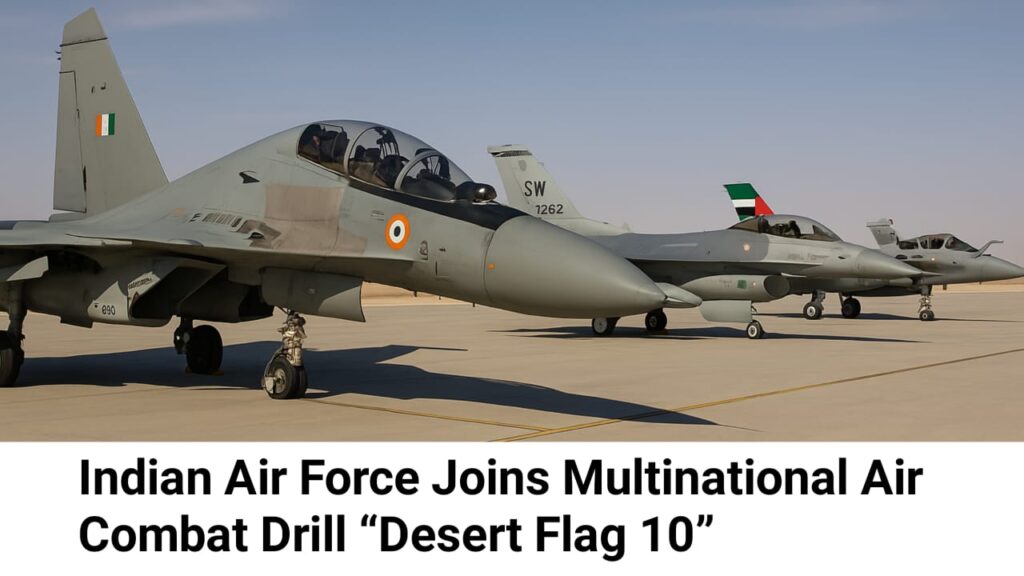Our Indian Air Force (IAF) has once again driven its symbol on the global stage by participating in the renowned multinational air combat drill known as Exercise Desert Flag 10. Held at the Al Dhafra Air Base in the United Arab Emirates (UAE), this high-profile drill runs from April 21 to May 8, 2025. The exercise brings together the air forces of ten nations, making it a significant platform for military cooperation, tactical learning, and interoperability.

A Platform for Global Collaboration
Exercise Desert Flag 10 is hosted by the UAE Air Force and is one of the most important multilateral air combat drills in the world. This year, participating countries include the United Arab Emirates, Australia, Saudi Arabia, France, the United Kingdom, the United States, and India among others.
The primary goal of the exercise is to simulate complex air combat scenarios that challenge the skills of fighter pilots and operational command units alike. Through mock combat drills, formation flying, and simulated wartime missions, the exercise aims to enhance the tactical and strategic capabilities of all the forces involved simultaneously.
Crucially, Desert Flag serves as a dais for the participating nations to share operational knowledge, learn best practices, and build stronger military partnerships. The presence of multiple air forces with varying strategies and technologies also provides a unique opportunity for joint training and collaboration in real-time scenarios.
India’s Participation and Strategic Significance
Our Indian Air Force has deployed with its complete advanced equipped MiG-29 and Jaguar fighter aircraft for this drill.
For showcasing its versatility and commitment to international Défense cooperation. Everyone knows the MiG-29 for its agility and combat capabilities, and the Jaguar, notable for its ground-attack accuracy, render key assets in India’s aerial fleet.
India’s participation is part of a broader diplomatic and strategic effort to deepen defense ties with both regional and global allies.
As threats to global security become increasingly complex and borderless, exercises like Desert Flag help Indian forces remain battle-ready and well-coordinated with allied nations.
The Indian Air Force
A Legacy of Valor set on October 8, 1932. Our Air Force is the air arm of the Indian Armed Forces. Initially formed as an auxiliary force under British rule, it was renamed the Royal Indian Air Force in 1945 in recognition of its exemplary service during World War II.
Following India’s transformation into a republic in 1950, the prefix “Royal” was dropped, and it became simply the Indian Air Force.
Over the decades, the IAF has played a pivotal role in safeguarding the nation’s airspace and asserting military dominance during conflicts. It has fought four major wars with Pakistan since 1950 and has been instrumental in several significant operations such as Operation Vijay (Kargil War), Operation Meghdoot (Siachen Glacier), Operation Cactus (Maldives crisis), and Operation Poomalai (Sri Lanka humanitarian mission).
The President of India serves as the Supreme Commander of the IAF, while operational control lies with the Chief of the Air Staff, a four-star Air Chief Marshal. The force is known for its discipline, technological innovation, and dedication to national service.
Final Thoughts
The Desert drill Flag 10 stands as a testament to the Indian Air Force’s growing global engagement and its ability to work in coalition domains. It not only highlights India’s military capabilities but also reinforces the country’s role in promoting peace and stability through international Défense cooperation.
As the exercise unfolds in the UAE, it will continue to provide invaluable experiences for pilots, commanders, and ground crews alike laying the foundation for stronger alliances and more secure skies.
Test Your Knowledge: Where is Exercise Desert Flag 10 being hosted?
A. Saudi Arabia
B. United States
C. United Arab Emirates
D. Qatar
Answer: C. United Arab Emirates






